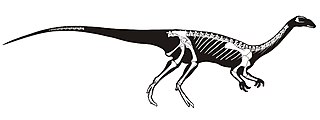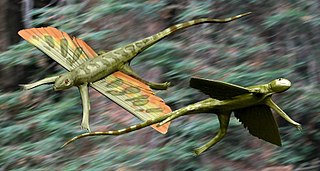
The Triassic is a geologic period and system which spans 50.5 million years from the end of the Permian Period 251.902 million years ago (Mya), to the beginning of the Jurassic Period 201.4 Mya. The Triassic is the first and shortest period of the Mesozoic Era and the seventh period of the Phanerozoic Eon. Both the start and end of the period are marked by major extinction events. The Triassic Period is subdivided into three epochs: Early Triassic, Middle Triassic and Late Triassic.

Cycads are seed plants that typically have a stout and woody (ligneous) trunk with a crown of large, hard, stiff, evergreen and (usually) pinnate leaves. The species are dioecious, that is, individual plants of a species are either male or female. Cycads vary in size from having trunks only a few centimeters to several meters tall. They typically grow slowly and have long lifespans. Because of their superficial resemblance to palms or ferns, they are sometimes mistaken for them, but they are not closely related to either group. Cycads are gymnosperms (naked-seeded), meaning their unfertilized seeds are open to the air to be directly fertilized by pollination, as contrasted with angiosperms, which have enclosed seeds with more complex fertilization arrangements. Cycads have very specialized pollinators, usually a specific species of beetle. Both male and female cycads bear cones (strobili), somewhat similar to conifer cones.

Saturnalia is an extinct genus of basal sauropodomorph dinosaur known from the Late Triassic Santa Maria Formation of Rio Grande do Sul, southern Brazil. It contains one species, Saturnalia tupiniquim. It is one of the earliest known dinosaurs.

Archosauriformes is a clade of diapsid reptiles encompassing archosaurs and some of their close relatives. It was defined by Jacques Gauthier (1994) as the clade stemming from the last common ancestor of Proterosuchidae and Archosauria. Phil Senter (2005) defined it as the most exclusive clade containing Proterosuchus and Archosauria. Gauthier as part of the Phylonyms (2020) defined the clade as the last common ancestor and all descendants of Gallus, Alligator, and Proterosuchus. Archosauriforms are a branch of archosauromorphs which originated in the Late Permian and persist to the present day as the two surviving archosaur groups: crocodilians and birds.
Phytosaurs are an extinct group of large, mostly semiaquatic Late Triassic archosauriform reptiles. Phytosaurs belong to the order Phytosauria and are sometimes referred to as parasuchians. Phytosauria, Parasuchia, Parasuchidae, and Phytosauridae have often been considered equivalent groupings containing the same species. Some recent studies have offered a more nuanced approach, defining Parasuchidae and Phytosauridae as nested clades within Phytosauria as a whole. The clade Phytosauria was defined by Paul Sereno in 2005 as Rutiodon carolinensis and all taxa more closely related to it than to Aetosaurus ferratus, Rauisuchus tiradentes, Prestosuchus chiniquensis, Ornithosuchus woodwardi, or Crocodylus niloticus. Phytosaurs were long-snouted and heavily armoured, bearing a remarkable resemblance to modern crocodilians in size, appearance, and lifestyle, as an example of convergence or parallel evolution.

Guaibasaurus is an extinct genus of basal saurischian dinosaur known from the Late Triassic Caturrita Formation of Rio Grande do Sul, southern Brazil. Most analyses recover it as a sauropodomorph, although there are some suggestions that it was a theropod instead. In 2016 Gregory S. Paul estimated it at 2 meters and 10 kg, whereas in 2020 Molina-Pérez and Larramendi listed it at 3 meters and 35 kg.

Aetosaurs are heavily armored reptiles belonging to the extinct order Aetosauria. They were medium- to large-sized omnivorous or herbivorous pseudosuchians, part of the branch of archosaurs more closely related to crocodilians than to birds and other dinosaurs. All known aetosaurs are restricted to the Late Triassic, and in some strata from this time they are among the most abundant fossil vertebrates. They have small heads, upturned snouts, erect limbs, and a body ornamented with four rows of plate-like osteoderms. Aetosaur fossil remains are known from Europe, North and South America, parts of Africa, and India. Since their armoured plates are often preserved and are abundant in certain localities, aetosaurs serve as important Late Triassic tetrapod index fossils. Many aetosaurs had wide geographic ranges, but their stratigraphic ranges were relatively short. Therefore, the presence of particular aetosaurs can accurately date a site in which they are found.

Camposaurus is a coelophysid dinosaur genus from the Norian stage of the Late Triassic period of North America. The pertinent fossil remains date back to the early to middle Norian stage, and is widely regarded as the oldest known neotheropod.

Arizonasaurus was a ctenosauriscid archosaur from the Middle Triassic. Arizonasaurus is found in the Middle Triassic Moenkopi Formation of northern Arizona. A fairly complete skeleton was found in 2002 by Sterling Nesbitt. The taxon has a large sailback formed by elongated neural spines of the vertebrae. The type species, Arizonasaurus babbitti, was named by Samuel Paul Welles in 1947.

Rhynchosaurs are a group of extinct herbivorous Triassic archosauromorph reptiles, belonging to the order Rhynchosauria. Members of the group are distinguished by their triangular skulls and elongated, beak like premaxillary bones. Rhynchosaurs first appeared in the Early Triassic, reaching their broadest abundance and a global distribution during the Carnian stage of the Late Triassic.

Hindeodus is an extinct genus of conodonts in the family Anchignathodontidae. The generic name Hindeodus is a tribute to George Jennings Hinde, a British geologist and paleontologist from the 1800s and early 1900s. The suffix -odus typically describes the animal's teeth, essentially making Hindeodus mean Hinde-teeth.

Proterochampsidae is a family of proterochampsian archosauriforms. Proterochampsids may have filled an ecological niche similar to modern crocodiles, and had a general crocodile-like appearance. They lived in what is now South America in the Middle and Late Triassic.

Kuehneosauridae is an extinct family of small, lizard-like gliding diapsids known from the Triassic period of Europe and North America.

Uatchitodon is an extinct genus of Late Triassic reptile known only from isolated teeth. Based on the structure of the teeth, Uatchitodon was probably a carnivorous archosauromorph. Folded grooves on the teeth indicate that the animal was likely venomous, with the grooves being channels for salivary venom. The teeth are similar to those of living venomous squamates such as Heloderma and venomous snakes. Uatchitodon is the earliest known venomous reptile.
The Clydonautilidae are Middle and Upper Triassic nautiloid cephalopods, which are derivatives of the clydonautiloidean family Liroceratidae, that have generally smooth, involute, globular to compressed shells, characterized by a suture with prominent lobes and saddles. The family is known to contain five genera, These are:

Loricata is a clade of archosaur reptiles that includes crocodilians and some of their Triassic relatives, such as Postosuchus and Prestosuchus. More specifically, Loricata includes Crocodylomorpha and most "rauisuchians", a paraphyletic grade of large terrestrial pseudosuchians which were alive in the Triassic period and ancestral to crocodylomorphs.

Doswelliidae is an extinct family of carnivorous archosauriform reptiles that lived in North America and Europe during the Middle to Late Triassic period. Long represented solely by the heavily-armored reptile Doswellia, the family's composition has expanded since 2011, although two supposed South American doswelliids were later redescribed as erpetosuchids. Doswelliids were not true archosaurs, but they were close relatives and some studies have considered them among the most derived non-archosaurian archosauriforms. They may have also been related to the Proterochampsidae, a South American family of crocodile-like archosauriforms.

Daemonosaurus is an extinct genus of possible theropod dinosaur from the Late Triassic of New Mexico. The only known fossil is a skull and neck fragments from deposits of the latest Triassic Chinle Formation at Ghost Ranch. Daemonosaurus was an unusual dinosaur with a short skull and large, fang-like teeth. It lived alongside early neotheropods such as Coelophysis, which would have been among the most common dinosaurs by the end of the Triassic. However, Daemonosaurus retains several plesiomorphic ("primitive") traits of the snout, and it likely lies outside the clade Neotheropoda. It may be considered a late-surviving basal theropod or non-theropod basal saurischian, possibly allied to other early predatory dinosaurs such as herrerasaurids or Tawa.
Callaionautilus is a genus of cephalopods included in the nautilid family Clydonautilidae that lived during the Late Triassic. Its fossils have been found on the island of Timor.

Azendohsauridae is a family of allokotosaurian archosauromorphs that lived during the Middle to Late Triassic period, around 242-216 million years ago. The family was originally named solely for the eponymous Azendohsaurus, marking out its distinctiveness from other allokotosaurs, but as of 2022 the family now includes four other genera: the basal genus Pamelaria, the large horned herbivore Shringasaurus, and two carnivorous genera grouped into the subfamily-level subclade Malerisaurinae, Malerisaurus and Puercosuchus, and potentially also the dubious genus Otischalkia. Most fossils of azendohsaurids have a Gondwanan distribution, with multiple species known across Morocco and Madagascar in Africa as well as India, although fossils of malerisaurine azendohsaurids have also been found in the southwestern United States of North America.
















